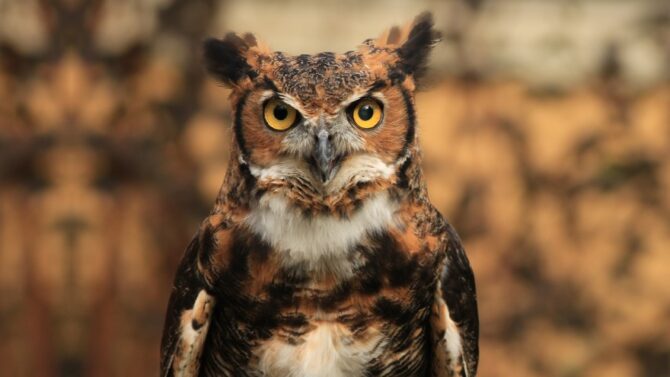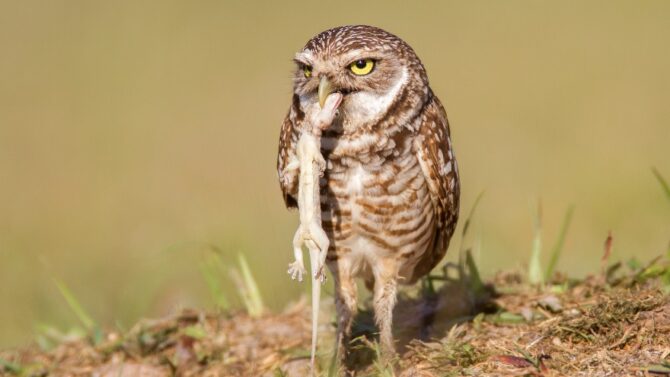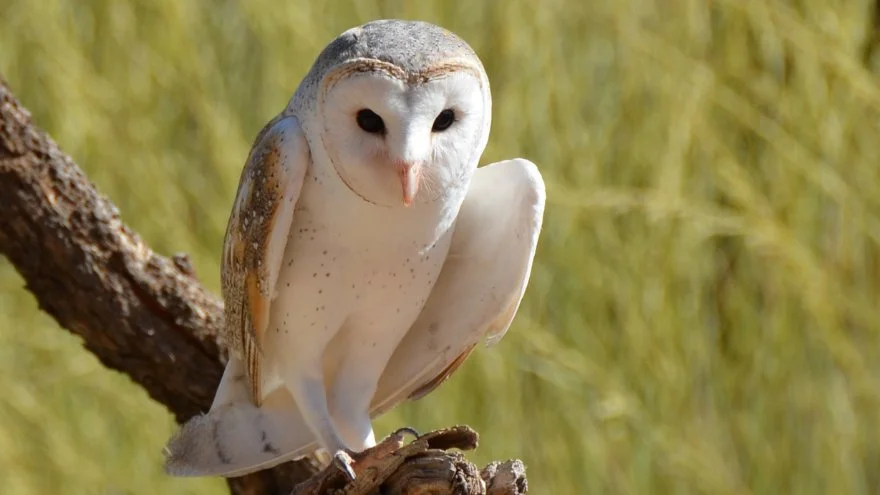Owls are birds belonging to the order Strigiformes. They are fascinating birds of prey, and it’s not just because of Harry Potter.
Feared by some and admired by others, owls leave an impression in every place they find themselves.
They are subdivided into two families (with other fossil families), 25 genera and 225 species.
The two extant families are the Strigidae and the Tytonidae. Under these families, we have species like the barn owl, snowy owl, barred owl, and great horned owl, among others.
We’ve selected the 20 most common types of owls for our list. Many can be found in the United States and other parts of the world. Read on to find out more.
Different Types of Owls – Most Popular Species
*The species list from 1–17 are under the Strigidae (True Owl) Family, while those from 18–20 are under the Tytonidae (Barn owl) family.
1. Great Horned Owl
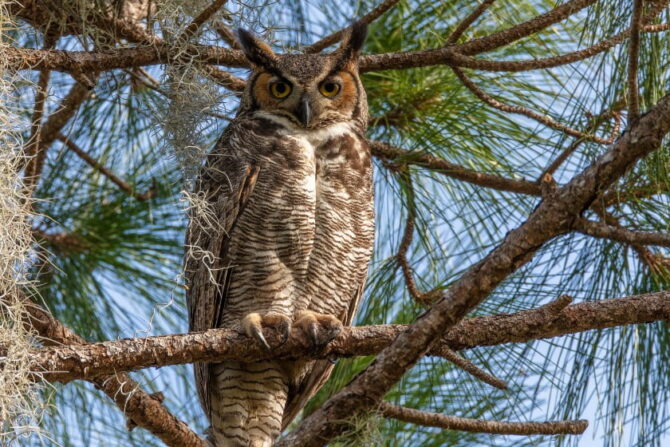
- Scientific Name: Bubo virgianus
- Length: 17 to 25 inches
- Weight: 2.6 to 3.5 pounds
- Wingspan: 3 to 5 ft
- Identifying Features: Mottled brown upper body, lighter underparts
- Range: Americas
- Habitat: Forests, swamps, deserts, subarctic tundra
- Conservative Status: Least Concern
The great horned owl is also known as the hoot owl or the tiger owl, and it is one of the well-known members of the Strigidae family.
It is native to the Americas, ranging from the North down to the South. You can find it in countries like Argentina, Peru, Bolivia, the United States, Salvador, and Panama.
Preferred habitats include different types of forests, swamps, and deserts.
This owl is recognized by its mottled brown upper parts with a light underbody. It is good for camouflage, coming in handy when it wants to hunt.
This bird is also quite big, and only the snowy owl is heavier in its region. It grows up to 25 inches and weighs more than 3 pounds.
The great horned owl is a carnivore, feeding on a variety of prey.
It seems to prefer mammals and birds, though not limited to those. Its call is a hoot, which explains the alternative name.
2. Barred Owl
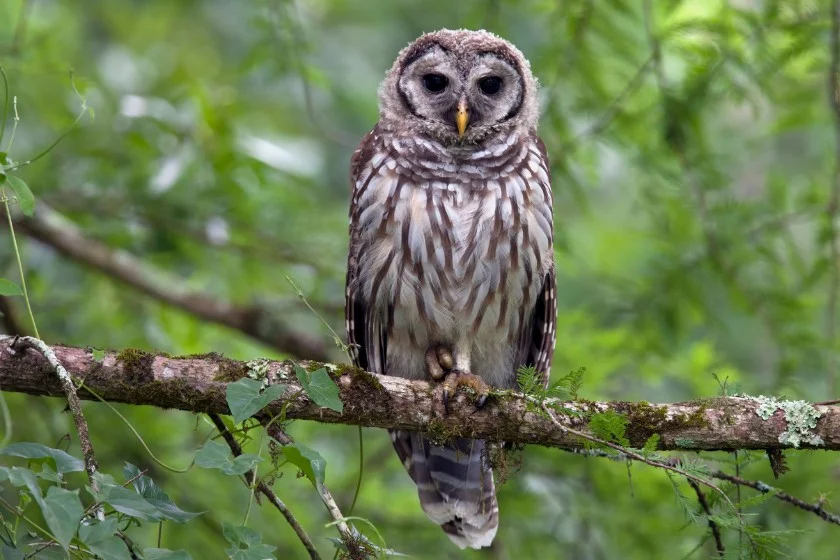
- Scientific Name: Strix varia
- Length: 16 to 25 inches
- Weight: 1 to 2 pounds
- Wingspan: 38 to 49 inches
- Identifying Features: brown plumage, yellow eyes, white bars
- Range: North America
- Habitat: Deciduous, mixed, coniferous forests
- Conservation Status: Least Concern
The barred owl is also called a hoot owl, much like the great horned owl. It is also known as the striped owl or the northern barred owl.
This bird is a native of North America, specifically the eastern part.
The western population was introduced later on. Its preferred habitats are forests.
The barred owl’s name points to the stripes on its plumage. The latter is on the mantle, back, and wing coverts.
Its overall color is brown or grayish brown. Completing this is a round head (no ear tufts) and black eyes.
The barred owl is the only true owl in the United States with yellow eyes.
This carnivorous bird feeds on different forms of prey, from mammals to birds, down to amphibians and the occasional fish.
It is nocturnal and does most of its hunting after sunset. The barred owl is very vocal, making a series of hoots.
3. Spotted Owl

- Scientific Name: Strix occidentalis
- Length: 17 inches
- Weight: 1.3 pounds
- Wingspan: 45 inches
- Identifying Features: White spots, dark brown eyes
- Range: North America
- Habitat: Forests, woodlands
- Conservation Status: Near Threatened
The spotted owl is a native of North America, living in habitats like forests and woodlands.
There are three known subspecies of the spotted owl, all of which are found in North America. The spotted owl stays in different forests and woodlands.
The spotted owl is similar to the barred owl, but there are differences in size and plumage color.
The barred owl is slightly bigger than the spotted owl, and the latter is less grey.
Its plumage is colored a dark brown with spots on the upper parts. It also has dark brown eyes.
The spotted owl is as nocturnal as others on the list, and it hunts at night. It feeds on small mammals and birds.
4. Ferruginous Pygmy Owl
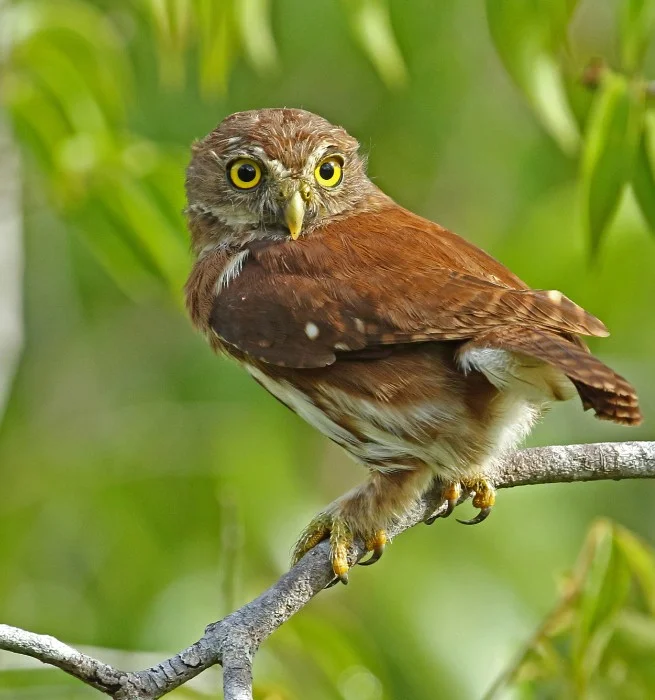
- Scientific Name: Glaucidum brasilioum
- Length: 5.9 inches
- Weight: 2.5 ounces
- Wingspan: 14.5 to 16 inches
- Identifying Features: White spots, short, stocky, brown plumage
- Range: Americas
- Habitat: Desert
- Conservation Status: Least Concern
The ferruginous pygmy owl is found in the North, South, and Central Americas. It is part of the pygmy owl genus named Glaucidum.
This genus comprises small birds that are sometimes called owlets. In the United States, it lives in Texas and Arizona.
Other countries you will find it is Mexico, Paraguay, Bolivia, and Argentina.
Besides being small, the ferruginous pygmy owl is short and stocky, giving it a cute edge.
Its plumage is predominantly brown, with spots on the underparts and the wing coverts.
It also has large feet and talons. Its eyes are yellow as well, which stands out.
The ferruginous pygmy owl is crepuscular, meaning that it hunts during dawn and twilight.
It also sometimes hunts during the day. It feeds on different types of animals, including lizards, birds, and other reptiles.
5. Eastern Screech Owl

- Scientific Name: Megascops Asio
- Length: 6.5 to 10 inches
- Weight: 4.25 to 8 ounces
- Wingspan: 18 to 24 inches
- Identifying Features: Dark gray or rusty color, round head, ear tufts,
- Range: North America
- Habitat: Woodlands, parklands, riparian woods
- Conservation Status: Least Concern
The eastern screech owl is a native of North America, found in countries like Mexico and Canada.
Its habitat preference seems to be wooded areas, but it can also be found around human habitats.
Good luck trying to find it, though. This bird tends to stay off human contact due to its nocturnal behaviors.
This bird is predominantly rusty or dark gray. The plumage also comes with patterns and streaks.
Other physical features are round heads, visible ear tufts, yellow eyes, and an equally yellow beak. It is one of the heaviest screech owls.
The name is a misnomer, however, as the eastern screech owl doesn’t screech.
Instead, its sound is a tremolo akin to a miniature horse. Its diet includes amphibians, birds, lizards, mammals, and other insects.
6. Western Screech Owl
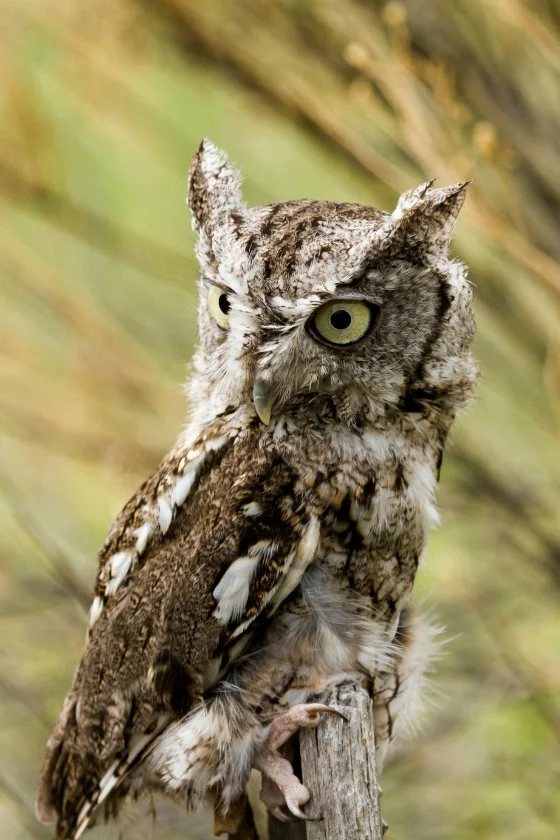
- Scientific Name: Megascops kennicotii
- Length: 8.7 inches
- Weight: 5 ounces
- Wingspan: 22 inches
- Identifying Features: brown or dark gray plumage, round head, ear tufts
- Range: Americas
- Habitat: Forests, shrublands, parks, gardens
- Conservation Status: Least Concern
The western screech owl is a close relative of the eastern screech owl, both of which are part of the genus Megascops.
They are similar in looks but considered different species. The western screech owl occurs in the Americas, where it inhabits different forest types, deserts, shrublands, parks, and fields.
This bird comes with predominantly brown or dark gray plumage, a great tool for camouflage when the owl wants to hunt.
The western screech also has the round head and ear tufts of its eastern screech brother.
The best way to differentiate these two species is with the call.
The western screech owl makes an actual screeching sound, though not limited to it. Other sounds include barking, chuckling, and whistling.
The western screech owl prefers hunting using the ambush method. It feeds mainly on small mammals and large insects.
7. Snowy Owl

- Scientific Name: Bubo scandiacus
- Length: 20 to 28 inches
- Weight: 3.2 to 6.5 pounds
- Wingspan: 3 ft 10 to 6 ft
- Identifying Features: White plumage, black or brown markings
- Range: North America, Paleartic
- Habitat: Tundra
- Conservation Status: Vulnerable
The snowy owl is a unique bird not always seen in the United States. It is nomadic, so the only times you’d see the snowy owl is during winter.
It’s always a pleasure to see these white creatures when they visit. The snowy owl’s main dwelling is the Arctic tundra, where it stays during its non-migratory moments.
It is also called the polar owl, the white owl, and the Arctic owl.
These birds are white, but it’s rare to find an individual that’s fully so. Most have black or brown markings on their wings.
Whiter individuals are usually older males as juveniles, and females tend to have more markings.
Snowy owls are diurnal, differing from the usual pattern. It does most of the hunting during the day.
These animals feed on mice, ducks, seabirds, and lemmings.
8. Eurasian Pygmy Owl

- Scientific Name: Glaucidium passerinum
- Length: 6 to 7.5 inches
- Weight: 1.8 to 2.7 ounces
- Wingspan: 12.6 to 15.35 inches
- Identifying Features: dark red or gray-brown color, spotted sides
- Range: Europe, Asia
- Habitat: Coniferous forests
- Conservation Status: Least Concern
The Eurasian pygmy owl is a native of Europe and Siberia. It is the smallest owl in Europe, being around the size of a sparrow.
Its preferred habitat is coniferous forests which they can be found year-round. Except in cases of harsh winter, the Eurasian pygmy owl doesn’t migrate.
The plumage color is either dark red or gray-brown, complete with spots on the back.
The tail also has white bars and is darker than other parts of the plumage.
Other physical features include a small head, gray eyebrows, and a white belly.
The vocal call of the Eurasian pygmy owl is loud, more than you might expect from a bird its size.
It has a higher pitch than a typical hoot, ringing out as flutes. Females are louder than males.
The Eurasian pygmy owl is crepuscular, being more active during the day.
9. Tawny Owl

- Scientific Name: Strix aluco
- Length: 15 to 18 inches
- Weight: 0.8 to 1.7 pounds
- Wingspan: 32 to 41 inches
- Identifying Features: Round head, dark brown eyes
- Range: Europe, Siberia
- Habitat: Deciduous, mixed forests
- Conservation Status: Least Concern
The tawny owl is a native of Europe and Siberia, much like the Eurasian pygmy owl.
There are seven recognized subspecies, often distinguished by their color differences.
The tawny owl inhabits deciduous and mixed forests, making a nest in tree holes.
This bird is described as stocky and medium-sized. Its underparts are pale, and the upper parts comes either brown or gray.
There are dark streaks on the underparts too. Additional physical features are the head bereft of ear tufts and brown eyes.
Tawny owls are nocturnal, though they don’t have any special eyesight. Their ears help them navigate the night, searching for potential prey.
It also knows how to fly silently, grabbing the prey from under. Its call is a clear hooting.
10. Great Gray Owl

- Scientific Name: Strix nebulosa
- Length: 24 to 33 inches
- Weight: 1.28 to 4.19 pounds
- Wingspan: 4 ft 7 to 5ft
- Identifying Features: Gray color, yellow eyes, round head
- Range: North America
- Habitat: Coniferous forests
- Conservation Status: Least Concern
The great gray owl is a large creature, considered one of the largest owls in the world.
It is native to North America, occurring in places like Quebec (Canada) and Alaska (the United States of America).
Its main habitat is the coniferous forest, usually close to open areas like meadows.
It also occurs in Europe, breeding in countries like Sweden and Norway.
As the name shows, the predominant plumage color is gray. The underpart is a lighter color with dark streaks.
Added to this is the white collar resembling a bow tie. Its head is round and brings out the face, but there is a notable absence of ear tufts.
The great gray owl hunts by waiting for prey, and once it locates any, it swoops and grabs.
It might also fly low, scouting for its next meal. This bird feeds on small rodents, ducks, hawks, etc.
11. Northern Saw Whet Owl
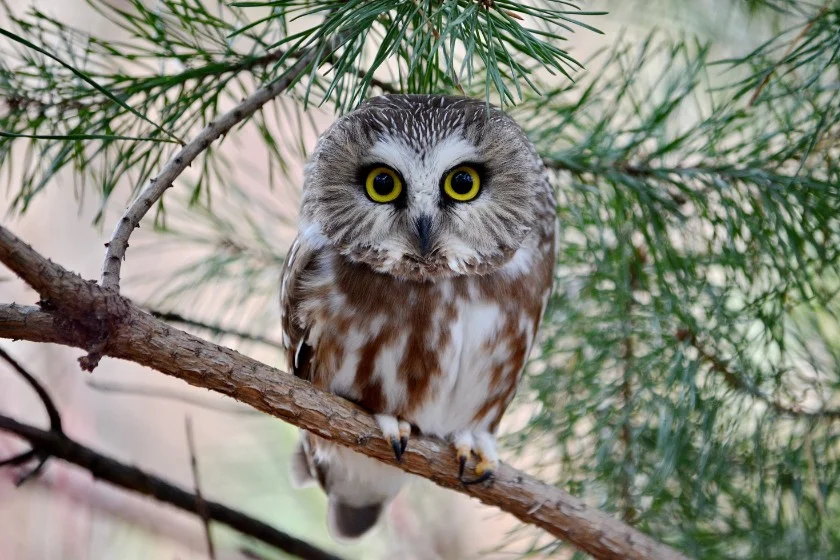
- Scientific Name: Aegolius acadius
- Length: 6.7 to 8.7 inches
- Weight: 1.9 to 5.3 ounces
- Wingspan: 16.5 to 22.1 inches
- Identifying Features: White face, yellow eyes, dark beak
- Range: North America
- Habitat: Coniferous forests, mixed or deciduous woods
- Conservation Status: Least Concern
The Northern saw-whet owl is a small bird that lives in the forests of North America.
Its genus is one of the smallest in the continent, alongside members of its genus Aegolius.
It is widely distributed in North America, occurring in the United States, Canada, and Mexico. It inhabits coniferous forests and mixed or deciduous woods.
The Northern saw-whet owl has a brown or red upper part and a rusty underside.
The upper part also has white spots. Added to these are the white face, dark beak, and yellow eyes. The face has streaks colored brown and cream.
Though common, the Northern saw-whet owl is hard to spot thanks to its size.
The best indicator is its call. It makes a whistling sound that’s described as a saw sharpened on a whetstone. This explains the name.
12. Long-eared Owl

- Scientific Name: Asio otus
- Length: 12 to 16 inches
- Weight: 5.6 to 15.3 pounds
- Wingspan: 2 ft 10 to 3 ft 14 inches
- Identifying Features: Ear tufts, slim body, brown color
- Range: North America, Europe, Paleartic
- Habitat: Woodland edge, open field
- Conservation Status: Least Concern
The long-eared owl occurs in North America, Europe, and the Paleartic regions. It prefers open areas, so you’d find it in habitats like fields and woodland edges.
Examples of countries it lives in are France, Norway, Sweden, the United States, and Finland.
As the name shows, the long-eared owl has protruding ear tufts that can stand upright.
Various theories have been preferred to explain the tufts. This bird is also known to have a surprised look.
It has a slim figure with plumage that’s mainly brown.
These birds are nocturnal, following the tradition of owls. Its activity commences at dusk, during which they look for prey. Diet is mainly focused on rodents.
13. Short-eared Owl
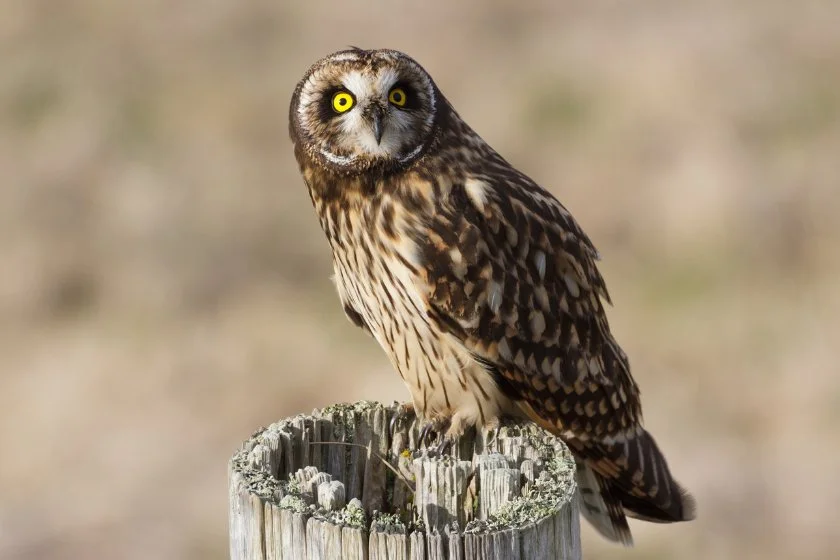
- Scientific Name: Asio flammeus
- Length: 13 to 17 inches
- Weight: 7.3 to 16.8 ounces
- Wingspan: 33 to 43 inches
- Identifying Features: Barred tail, short bill, mottled plumage
- Range: Worldwide
- Habitat: Open country, grasslands
- Conservation Status: Least Concern
The short-eared owl is a relative of the long-eared owl, both of them belonging to the Asio genus.
It is a widespread species, occurring in all continents except Antarctica and Australia.
The short-eared owl inhabits open areas, and you can find it in the open country and grasslands. It is considered partially migratory.
The ear tufts of this species aren’t visible, though they stand just like those of the long-eared owl.
Besides that, other outstanding features of the short-eared owl are the barred tail and the mottled plumage.
The short-eared owl is different from other owls in many ways. While it hunts at night, it is also crepuscular and diurnal.
Its flight pattern is unique too, resembling that of the moth. The short-eared owl feeds mainly on rodents.
14. Burrowing Owl

- Scientific Name: Athene cunicularia
- Length: 7 to 11 inches
- Weight: 5 to 8 ounces
- Wingspan: 20 to 24 inches
- Identifying Features: dark yellow beak, brown head, spotted wings
- Range: North and South America
- Habitat: Open grasslands
- Conservation Status: Least Concern
The burrowing owl is a native of North and South America, living mainly in open areas.
Its habitat includes grasslands, rangelands, deserts, and agricultural areas.
Unlike other owl species that build their homes in nests, the burrowing owl stays in abandoned burrows left by prairie dogs. This explains the name.
To live well in its habitat, the burrowing owl has long legs that it uses to pursue prey.
The head and wings are brown spotted, but the underside is white with some brown spots.
Colors may vary depending on the subspecies. The burrowing owl also comes with bright eyes and a beak that could be either yellow or gray, depending on the subspecies.
Burrowing owls feed on both invertebrates and vertebrates, mainly feeding on rodents with insects.
15. Striped Owl

- Scientific Name: Asio clamator
- Length: 12 to 15 inches
- Weight: 11.3 to 19.3 ounces
- Wingspan: 39 to 43.3 inches
- Identifying Features: Brown with black stripes, buff underparts
- Range: South America, Central America
- Habitat: Riparian woodlands, savannahs, marshes, tropical rainforests
- Conservation Status: Least Concern
The striped owl is a native of South and Central America, inhabiting a variety of habitats.
These include marshes, riparian woodlands, savannahs, and tropical rainforests. It belongs to the Asio genus, well observed by the ear tufts.
As the name implies, the striped owl is fully striped, coming off as an avian tiger.
Added to this is the long ear tuft. The striped owl also has a brownish-white face, cinnamon eyes, a dark beak, and very short wings.
16. Boreal Owl
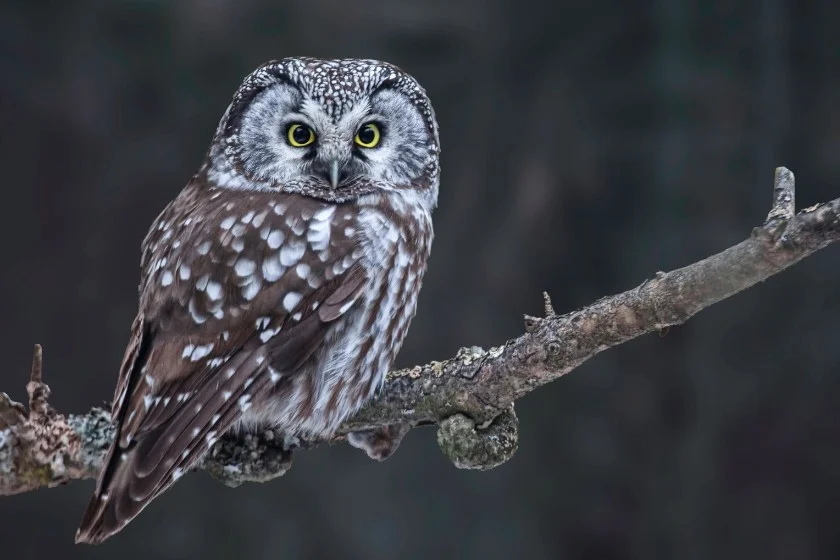
- Scientific Name: Aegolius funereus
- Length: 8.7 to 10.6 inches
- Weight: 3.8 to 6.3 ounces
- Wingspan: 20 to 24 inches
- Identifying Features: Brown plumage, white underparts, rust streaks
- Range: North America, Palearctic
- Habitat: Dense coniferous forests, mountains
- Conservation Status: Least Concern
The boreal owl is also known as the Tengmalm’s owl in Europe. It is sometimes called the Richardson’s owl too, though this is rare.
The boreal owl inhabits coniferous forests in North America and stays in the wild.
Autumn often sees these birds traveling to other places, though they are not migratory.
Boreal owls are predominantly dark brown, but the underside is white. There are touches of white on the shoulders and rust streaks on the underparts.
Then we have the yellow eyes and an equally yellow beak connected to a large head. The boreal owl is small, reaching around 10 inches in length.
17. Blakiston’s Fish Owl
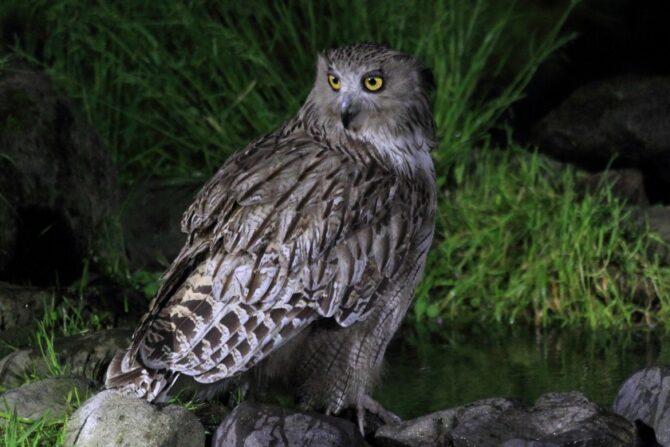
- Scientific Name: Ketupa blakistoni
- Length: 24 to 28 inches
- Weight: 6.5 to 7.9 pounds
- Wingspan: 5 ft 10 to 6 ft 3 inches
- Identifying Features: Long bill, buff upperparts, white throat
- Range: China, Japan
- Habitat: Riparian forests
- Conservation Status: Endangered
The Blakiston’s fish owl is considered the largest living owl species occurring in Asia. It specifically stays in China, Japan, and Russia (the eastern side).
It is classified under the genus Ketupa, known also as the fish owl.
In size, it has competitors in the Eurasian eagle owl and the great gray owl. However, it outgrows its competitors.
The Blakiston’s fish owl’s upper part is buff with streaks. The underpart takes on a lighter shade of brown and with fewer streaks than the upper parts.
This fish owl also has protruding ear tufts. Other features include a white throat, a long bill, and a yellow iris.
18. Barn Owl
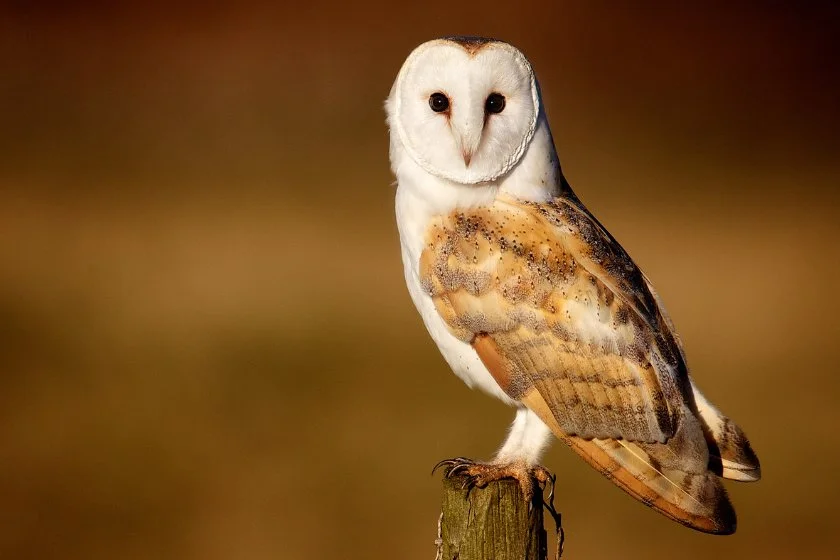
- Scientific Name: Tyto Alba
- Length: 13 to 15 inches
- Weight: 9.2 to 19.6 ounces
- Wingspan: 31 to 37 inches
- Identifying Features: Brown, pale brown, gray
- Range: Worldwide (with some exceptions)
- Habitat: Barns, old churches
- Conservation Status: Least Concern
What better owl to lead the category of barn owls than the species by the same name?
The barn owl goes by some other names, like the common barn owl, so it won’t be confused with the Tytonidae family itself.
It is the most widespread owl in the world, occurring in all continents except Antarctica. It dwells in old barns, hence the name.
Barn owls have a haunting look, fuelling the myth of it being a sign of a bad omen. Its face is usually white, and its eyes black.
The upper part is either brown or gray, depending on the subspecies. The lower parts are either white or reddish buff, again depending on the subspecies.
A major difference between the Tytonidae and Strigidae families is that the latter (not all) hoots while the former doesn’t.
As a member of the Tytonidae family, the barn owl doesn’t hoot. Rather, it makes a shree sound that rings out loud.
19. Australian Masked Owl

- Scientific Name: Tyto novaehollandiae
- Length: 13 to 16 inches
- Weight: 0.93 to 2.7 pounds
- Wingspan: 50 inches
- Identifying Features: Brown plumage, gray spots
- Range: Australia, New Guinea
- Habitat: Timbered areas
- Conservation Status: Least Concern
The Australian masked owl is from Australia–as the name shows–staying in the non-desert areas.
You can also find it on the island of New Guinea. As a member of the Tytonidae family, it has similar looks to the barn owl.
It lives in areas with trees, making a home out of hollows.
The Australian masked owl has the pale looks of the aforementioned barn owl, complete with a white face and dark eyes.
The overall plumage is brown with white spots, alongside a combination of light gray at the back. Females tend to be larger than males.
20. American Barn Owl
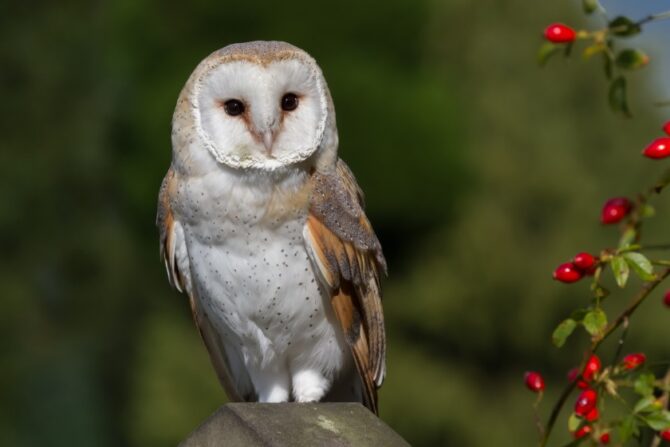
- Scientific Name: Tyto furcata
- Length: 13 to 15 inches
- Weight: 1 to 1.5 pounds
- Wingspan: 40 to 50 inches
- Identifying Features: Long wings, pale plumage
- Range: Americas
- Habitat: Farmland, grasslands
- Conservation Status: Not extinct
There are some disagreements over the classification of the American barn owl.
On one hand, it is regarded as a subspecies of the barn owl. On the other hand, some experts classify it as a distinct species.
We list it as the latter in this article. As the name shows, the American barn owl is a native of North America.
It inhabits farmlands and grasslands, unlike the common barn owl.
The American barn owl has the same face as both the common barn owl and the Australian masked owl.
Its upper part is colored brown, with the underside being white. Some come with patterns.
The American barn owl is medium-sized and flies in an undulating manner, similar to other Tytonidae owls.
Final Thoughts
There are many different types of owls, but we’ve been able to capture some of the well-known species on our list from both the Tytonidae and Strigidae families.
This ranges from the largest living owl to smaller ones termed “Pygmy” for good reasons.
Did we include your favorite species? Which other one do you know? Let us know in the comments below!
